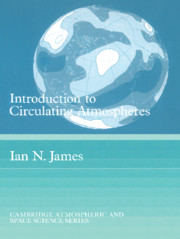Book contents
- Frontmatter
- Contents
- Preface
- Notation
- l The governing physical laws
- 2 Observing and modelling global circulations
- 3 The atmospheric heat engine
- 4 The zonal mean meridional circulation
- 5 Transient disturbances in the midlatitudes
- 6 Wave propagation and steady eddies
- 7 Three-dimensional aspects of the global circulation
- 8 Low frequency variability of the circulation
- 9 The stratosphere
- 10 Planetary atmospheres and other fluid systems
- Appendix: Solutions to Problems
- Bibliography
- References
- Index
7 - Three-dimensional aspects of the global circulation
Published online by Cambridge University Press: 14 January 2010
- Frontmatter
- Contents
- Preface
- Notation
- l The governing physical laws
- 2 Observing and modelling global circulations
- 3 The atmospheric heat engine
- 4 The zonal mean meridional circulation
- 5 Transient disturbances in the midlatitudes
- 6 Wave propagation and steady eddies
- 7 Three-dimensional aspects of the global circulation
- 8 Low frequency variability of the circulation
- 9 The stratosphere
- 10 Planetary atmospheres and other fluid systems
- Appendix: Solutions to Problems
- Bibliography
- References
- Index
Summary
Zonal variations in the tropics
Up to this point, we have followed a traditional exposition of the global circulation by concentrating upon the zonal mean circulation and upon the zonal mean fields of eddy quantities. But the global circulation is far from zonally symmetric. Tropical heating has distinct maxima at particular longitudes. In the midlatitudes, the transient eddies are not distributed uniformly around the latitude circles, but are concentrated into isolated ‘storm tracks’, especially in the northern hemisphere. This chapter will be devoted to a description of such zonal asymmetries and their consequences.
The various diagnostics of the steady and transient eddy activity which we have considered in earlier chapters become small in the tropics. Eddy kinetic energy is much smaller in the tropics than in the midlatitudes. Similarly, eddy temperature and momentum fluxes, both steady and transient, are much smaller in the tropics. Thus a picture emerges in which heat and momentum are transported, essentially by axisymmetric motions in the tropics, with eddies taking over in the subtropics and midlatitudes.
There is some truth in this picture. But it can also be misleading. First, consider the heating fields shown in Fig. 3.8. The forcing of the circulation is certainly not axisymmetric, especially in the tropics. Rather, there are a small number of centres of intense heating.
- Type
- Chapter
- Information
- Introduction to Circulating Atmospheres , pp. 208 - 254Publisher: Cambridge University PressPrint publication year: 1994



